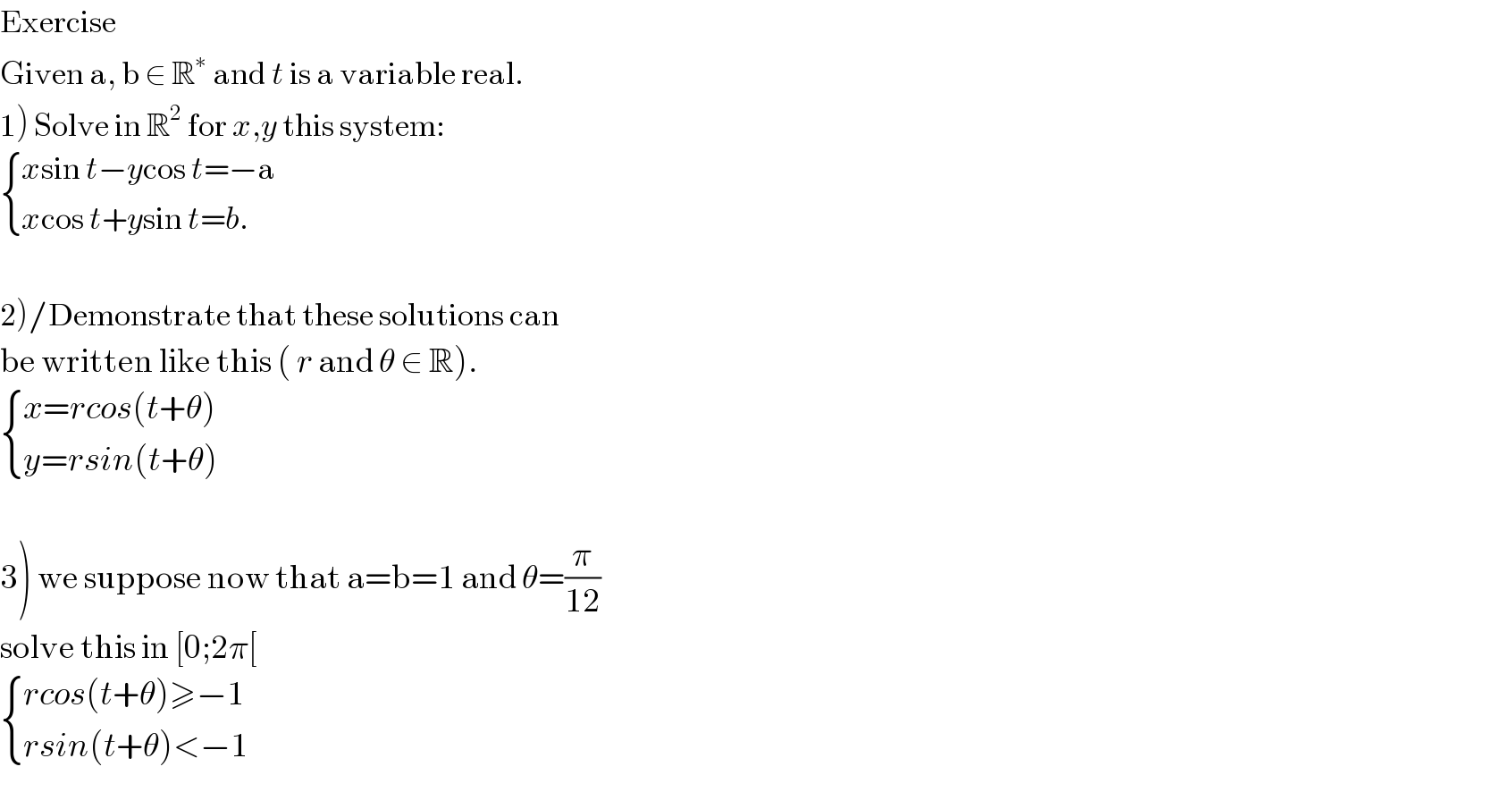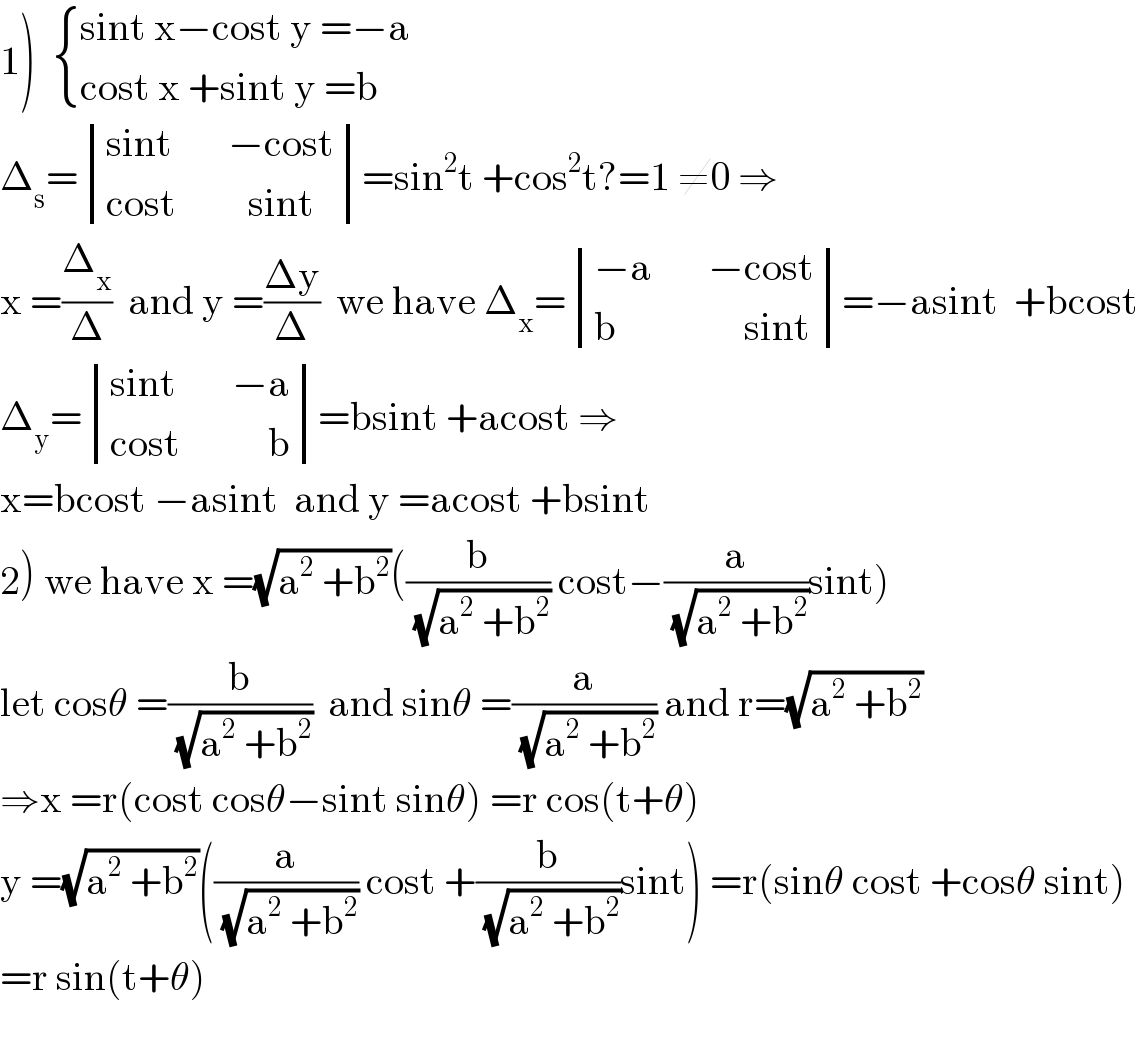Question Number 95001 by mathocean1 last updated on 22/May/20

$$\mathrm{Exercise} \\ $$$$\mathrm{Given}\:\mathrm{a},\:\mathrm{b}\:\in\:\mathbb{R}^{\ast} \:\mathrm{and}\:{t}\:\mathrm{is}\:\mathrm{a}\:\mathrm{variable}\:\mathrm{real}. \\ $$$$\left.\mathrm{1}\right)\:\mathrm{Solve}\:\mathrm{in}\:\mathbb{R}^{\mathrm{2}} \:\mathrm{for}\:{x},{y}\:\mathrm{this}\:\mathrm{system}:\: \\ $$$$\begin{cases}{{x}\mathrm{sin}\:{t}−{y}\mathrm{cos}\:{t}=−\mathrm{a}}\\{{x}\mathrm{cos}\:{t}+{y}\mathrm{sin}\:{t}={b}.}\end{cases} \\ $$$$ \\ $$$$\left.\mathrm{2}\right)/\mathrm{Demonstrate}\:\mathrm{that}\:\mathrm{these}\:\mathrm{solutions}\:\mathrm{can} \\ $$$$\mathrm{be}\:\mathrm{written}\:\mathrm{like}\:\mathrm{this}\:\left(\:{r}\:\mathrm{and}\:\theta\:\in\:\mathbb{R}\right). \\ $$$$\begin{cases}{{x}={rcos}\left({t}+\theta\right)}\\{{y}={rsin}\left({t}+\theta\right)}\end{cases} \\ $$$$ \\ $$$$\left.\mathrm{3}\right)\:\mathrm{we}\:\mathrm{suppose}\:\mathrm{now}\:\mathrm{that}\:\mathrm{a}=\mathrm{b}=\mathrm{1}\:\mathrm{and}\:\theta=\frac{\pi}{\mathrm{12}} \\ $$$$\mathrm{solve}\:\mathrm{this}\:\mathrm{in}\:\left[\mathrm{0};\mathrm{2}\pi\left[\right.\right. \\ $$$$\begin{cases}{{rcos}\left({t}+\theta\right)\geqslant−\mathrm{1}}\\{{rsin}\left({t}+\theta\right)<−\mathrm{1}}\end{cases} \\ $$
Answered by bobhans last updated on 22/May/20

$$\left(\mathrm{1}\right)\Rightarrow\left(\mathrm{i}\right)\mathrm{x}^{\mathrm{2}} \mathrm{sin}\:^{\mathrm{2}} \mathrm{t}−\mathrm{2xysin}\:\mathrm{tcos}\:\mathrm{t}+\mathrm{y}^{\mathrm{2}} \mathrm{cos}\:^{\mathrm{2}} \mathrm{t}\:=\:\mathrm{a}^{\mathrm{2}} \\ $$$$\Rightarrow\left(\mathrm{ii}\right)\mathrm{x}^{\mathrm{2}} \mathrm{cos}\:^{\mathrm{2}} \mathrm{t}+\mathrm{2xycos}\:\mathrm{tsin}\:\mathrm{t}+\mathrm{y}^{\mathrm{2}} \mathrm{sin}\:^{\mathrm{2}} \mathrm{t}\:=\:\mathrm{b}^{\mathrm{2}} \\ $$$$\left(\mathrm{i}\right)+\left(\mathrm{ii}\right)\:\Rightarrow\:{x}^{\mathrm{2}} +\:{y}^{\mathrm{2}} −\mathrm{2}{xy}\left(\mathrm{sin}\:{t}\mathrm{cos}\:{t}−\mathrm{cos}\:{t}\mathrm{sin}\:{t}\right)\:=\:{a}^{\mathrm{2}} +{b}^{\mathrm{2}} \\ $$$$\Rightarrow\:{x}^{\mathrm{2}} \:+\:{y}^{\mathrm{2}} \:=\:{a}^{\mathrm{2}} \:+\:{b}^{\mathrm{2}} \: \\ $$
Answered by mathmax by abdo last updated on 22/May/20

$$\left.\mathrm{1}\right)\:\:\begin{cases}{\mathrm{sint}\:\mathrm{x}−\mathrm{cost}\:\mathrm{y}\:=−\mathrm{a}}\\{\mathrm{cost}\:\mathrm{x}\:+\mathrm{sint}\:\mathrm{y}\:=\mathrm{b}}\end{cases} \\ $$$$\Delta_{\mathrm{s}} =\begin{vmatrix}{\mathrm{sint}\:\:\:\:\:\:\:−\mathrm{cost}}\\{\mathrm{cost}\:\:\:\:\:\:\:\:\:\mathrm{sint}}\end{vmatrix}=\mathrm{sin}^{\mathrm{2}} \mathrm{t}\:+\mathrm{cos}^{\mathrm{2}} \mathrm{t}?=\mathrm{1}\:\neq\mathrm{0}\:\Rightarrow \\ $$$$\mathrm{x}\:=\frac{\Delta_{\mathrm{x}} }{\Delta}\:\:\mathrm{and}\:\mathrm{y}\:=\frac{\Delta\mathrm{y}}{\Delta}\:\:\mathrm{we}\:\mathrm{have}\:\Delta_{\mathrm{x}} =\begin{vmatrix}{−\mathrm{a}\:\:\:\:\:\:\:−\mathrm{cost}}\\{\mathrm{b}\:\:\:\:\:\:\:\:\:\:\:\:\:\:\:\:\mathrm{sint}}\end{vmatrix}=−\mathrm{asint}\:\:+\mathrm{bcost} \\ $$$$\Delta_{\mathrm{y}} =\begin{vmatrix}{\mathrm{sint}\:\:\:\:\:\:\:−\mathrm{a}}\\{\mathrm{cost}\:\:\:\:\:\:\:\:\:\:\:\mathrm{b}}\end{vmatrix}=\mathrm{bsint}\:+\mathrm{acost}\:\Rightarrow \\ $$$$\mathrm{x}=\mathrm{bcost}\:−\mathrm{asint}\:\:\mathrm{and}\:\mathrm{y}\:=\mathrm{acost}\:+\mathrm{bsint} \\ $$$$\left.\mathrm{2}\right)\:\mathrm{we}\:\mathrm{have}\:\mathrm{x}\:=\sqrt{\mathrm{a}^{\mathrm{2}} \:+\mathrm{b}^{\mathrm{2}} }\left(\frac{\mathrm{b}}{\:\sqrt{\mathrm{a}^{\mathrm{2}} \:+\mathrm{b}^{\mathrm{2}} }}\:\mathrm{cost}−\frac{\mathrm{a}}{\:\sqrt{\mathrm{a}^{\mathrm{2}} \:+\mathrm{b}^{\mathrm{2}} }}\mathrm{sint}\right) \\ $$$$\mathrm{let}\:\mathrm{cos}\theta\:=\frac{\mathrm{b}}{\:\sqrt{\mathrm{a}^{\mathrm{2}} \:+\mathrm{b}^{\mathrm{2}} }}\:\:\mathrm{and}\:\mathrm{sin}\theta\:=\frac{\mathrm{a}}{\:\sqrt{\mathrm{a}^{\mathrm{2}} \:+\mathrm{b}^{\mathrm{2}} }}\:\mathrm{and}\:\mathrm{r}=\sqrt{\mathrm{a}^{\mathrm{2}} \:+\mathrm{b}^{\mathrm{2}} } \\ $$$$\Rightarrow\mathrm{x}\:=\mathrm{r}\left(\mathrm{cost}\:\mathrm{cos}\theta−\mathrm{sint}\:\mathrm{sin}\theta\right)\:=\mathrm{r}\:\mathrm{cos}\left(\mathrm{t}+\theta\right) \\ $$$$\mathrm{y}\:=\sqrt{\mathrm{a}^{\mathrm{2}} \:+\mathrm{b}^{\mathrm{2}} }\left(\frac{\mathrm{a}}{\:\sqrt{\mathrm{a}^{\mathrm{2}} \:+\mathrm{b}^{\mathrm{2}} }}\:\mathrm{cost}\:+\frac{\mathrm{b}}{\:\sqrt{\mathrm{a}^{\mathrm{2}} \:+\mathrm{b}^{\mathrm{2}} }}\mathrm{sint}\right)\:=\mathrm{r}\left(\mathrm{sin}\theta\:\mathrm{cost}\:+\mathrm{cos}\theta\:\mathrm{sint}\right) \\ $$$$=\mathrm{r}\:\mathrm{sin}\left(\mathrm{t}+\theta\right) \\ $$$$ \\ $$
Commented by mathocean1 last updated on 08/Jun/20

$${thanks}\:{sir} \\ $$
